
Catalog excerpts

Implants trauma Twist-Off Screw
Open the catalog to page 1
CAUTION: Federal Law (USA) restricts this device to sale by or on the order of a board certified physician. WARNING: If there is no sufficient bone healing, wrong or incomplete postoperative care, implant might break. ATTENTION: The ITS. Twist-Off Screws are not suitable for use in the spinal column. The indication range for twist-off screws may vary according to the bone quality and physique of the patient.
Open the catalog to page 2
1. Introduction P. 5 Preface P. 6 Properties P. 7 Instruments P. 8 Indications & Contraindications P. 8 Time of operation 2. Surgical technique P. 10 Temporary fixation P. 10 Identification of screw length P. 11 Placement of the screw P. 12 Postoperative treatment P. 12 Explantation 3. Information P. 13 Dotize® P. 14 Order list P. 16 Reconditioning Manual P. 18 Notes
Open the catalog to page 3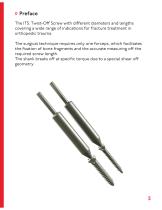
The ITS. Twist-Off Screw with different diameters and Lengths covering a wide range of indications for fracture treatment in orthopedic trauma. The surgical technique requires only one forceps, which facilitates the fixation of bone fragments and the accurate measuring off the required screw length. The shank breaks off at specific torque due to a special shear off geometry.
Open the catalog to page 5
Properties Properties of the implant: • Self-drilling & self-tapping • Special shear off geometry facilitates a smooth break between shaft and screw at specific torque • Diameter 2.0mm and 2.7mm • Forceps enables fixation of bone fragments as well as accurate measuring off the required screw length • Clamping of the screw directly in the machine with wire attachement • Fast and stable fixation • Final insertion with specially adapted screwdriver Screw material: TiAl6V4 ELI Easier removal of the implant after the fracture has healed Improved fatigue strength of the implant Reduced risk of...
Open the catalog to page 6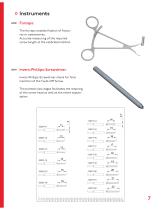
O Instruments 62830 Forceps: The forceps enables fixation of fractures or osteotomies. Accurate measuring of the required screw Length at the calibrated ratchet. 56504 Invers-Phillips-Screwdriver: Invers-Phillips-Screwdriver shank for final insertion of the Twist-Off Screw. The pointed claw edges facilitates the retaining of the screw head as well as the entire explantation.
Open the catalog to page 7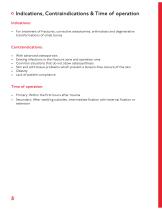
Indications: ♦ For treatment of fractures, corrective osteotomies, arthrodesis and degenerative transformations of small bones Contraindications: ♦ With advanced osteoporosis ♦ Existing infections in the fracture zone and operation area • Common situations that do not allow osteosynthesis • Skin and soft-tissue problems which prevent a tension-free closure of the skin • Obesity • Lack of patient compliance Time of operation: • Primary: Within the first hours after trauma • Secondary: After swelling subsides, intermediate fixation with external fixation or extension
Open the catalog to page 8
Surgical Technique
Open the catalog to page 9
o Temporary fixation After placing a stab incision, provisionally fix the fracture or osteotomy using the forceps (62830). Subsequent control under fluoroscopy. Tighten the forceps so the screw guidance is at least 90° angle to the fracture or osteotomy. Then read off the required length measurement at the calibrated ratchet. Attention: Tighten the forceps gently to prevent measuring error! Select the screw length carefully so that the screw obtains purchase in the far cortex but not penetrate into the soft tissue.
Open the catalog to page 10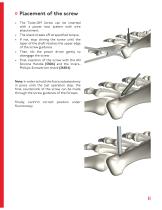
Note: In order to hold the fracture/osteotomy in place until the last operation step, the final countersink of the screw can be made through the screw guidance of the forceps. Finally, confirm correct position under fluoroscopy.
Open the catalog to page 11
Postoperative treatment • • • • Physical therapy immediately following surgery (no immobilization required) Partial weight-bearing Full weight-bearing after week 10-16 Weight-bearing after radiographic verification of the healed bone ATTENTION: The postoperative treatment may vary depending on the patient‘s age, bone quality or type of fracture. Removal is possible, if desired by the patient. Implant removal is performed after radiographic verification. Skin incision following the old scar Remove the screw with the AO Silicone Handle (53016) and the Invers-PhillipsScrewdriver shank (56504).
Open the catalog to page 12
Dotize® Chemical process - anodization in a strong alkaline solution* Dotize Type II anodization • Layer thickness 2000-10 000nm + Film becomes an interstitial part of the titanium + Different colors - Implant surface remains sensitive to: Chipping Peeling Discoloration - No visible cosmetic effect Anodization Type II leads to following benefits* • • • • • • • • Oxygen and silicon absorbing conversion layer Decrease in protein adsorption Closing of micro pores and micro cracks Reduced risk of inflammation and allergy Hardened titanium surface Reduced tendency of cold welding of titanium...
Open the catalog to page 13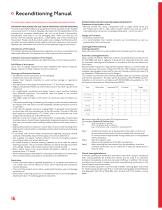
The information below should help you in reconditioning medical devices. IMPORTANT INDICATIONS FOR DOCTORS & OPERATING THEATRE PERSONNEL This instruction Leaflet refers to all supplied non-steriLe implants and all reusable instruments from I.T.S. GmbH. Detailed information for the identification of the product (such as system classification, cat. no.) can be found in the product identification code and/ or on the packaging label. Make sure that you are familiar with the possible application, combinability and correct handling of the product. Please note that product systems can undergo...
Open the catalog to page 16
Sterilisation with steam: Fractionated vacuum procedure (at least 3 pre-vacuum phases) Manual disinfection If a cleaning agent without a disinfectant effect is used, separate disinfection must be carried out after manual cleaning. (Order: Decontamination for staff protection, cleaning, disinfection). Equipment: Commercially available disinfectant authorised for use with medical products from the VAH list. Manufacturer's information, e.g. concerning concentration, temperature and exposure time should be followed. The steps described in the table above also apply. Drying See table...
Open the catalog to page 17All I.T.S. catalogs and technical brochures
-
ufs
1 Pages
-
DHL
2 Pages
-
ITS
2 Pages
-
PHL
24 Pages
-
ACLS
20 Pages
-
CFN
32 Pages
-
OLS
24 Pages
-
PHLs
20 Pages
-
CTN - Cannulated Tibia Nail
28 Pages
-
SR Sacral Rods
20 Pages
-
HCS
24 Pages
-
TLS
20 Pages
-
PRS-RX
32 Pages
-
HLS
20 Pages
-
ES
20 Pages
-
SR
20 Pages
-
FL
24 Pages
-
PL - Pilon Locking Plate small
12 Pages
-
OL - Olecranon Locking Plate
24 Pages
-
CAS
40 Pages
-
FCN
20 Pages
-
HOL
24 Pages
-
FLS
24 Pages
-
PFL
20 Pages
-
DTL
24 Pages
-
HTO
24 Pages
-
PTL
32 Pages
-
DFL
32 Pages
-
SCL
32 Pages
-
SLS
24 Pages
-
CAL
20 Pages
-
DUL
24 Pages
-
CLS
28 Pages



























































